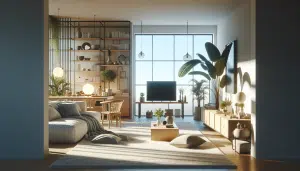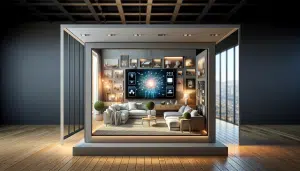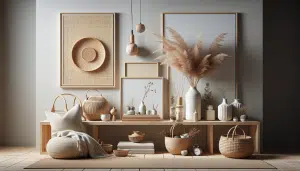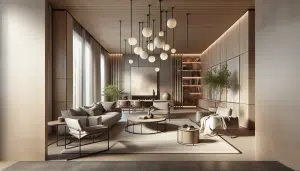Simple Ways to Make Your Living Space Feel Luxurious
Lily Carter October 17, 2025
Transforming your home’s atmosphere doesn’t have to cost a fortune. Discover fresh ideas and clever lifestyle tweaks that can make any living space feel more luxurious, comfortable, and tailored to your needs. This guide explores practical design tips, wellness influences, budget-friendly details, and more.
Small Design Changes With Major Impact
Subtle design elements can dramatically change how a room feels. Even minor adjustments, such as adding layered lighting or rearranging furniture, help create a sense of spaciousness and flow. These effortless design updates are popular in interior magazines and online home tours because they offer an accessible way to boost a room’s appeal with minimal investment. For example, placing a floor lamp in a dark corner can open up the entire space.
Budget-friendly details, like throw pillows or new curtain panels, are highly sought-after in lifestyle blogs. Texture and color can turn an ordinary sofa into a statement piece, changing the mood without a pricey overhaul. Consider mixing tactile fabrics or playing with geometric patterns. This can freshen up the look while still keeping the core elements of your living area familiar.
Mirrors, often recommended by designers, bring instant lightness and depth into smaller rooms. A carefully placed mirror reflects natural sunlight, making spaces appear larger—and grander—than their measurements. For apartment dwellers and homeowners alike, a single, well-positioned mirror becomes a secret weapon to enhance both atmosphere and perceived space.
Incorporating Personal Wellness Elements
Wellness-driven design is thriving in the lifestyle and entertainment sectors. Aromatherapy diffusers, gentle soundscapes, and calming plants are just a few ways people introduce relaxation into daily living. Personal wellness spaces don’t need complex renovations. A cozy reading nook, a small indoor fountain, or a tabletop garden can create moments of tranquility in any environment. These features encourage a calming mood after busy days.
Experts suggest that indoor air quality and greenery contribute significantly to comfort and luxury in living areas https://www.ncbi.nlm.nih.gov/pmc/articles/PMC4419447/. Snake plants, peace lilies, and pothos require little care but make a striking difference in oxygen flow and aesthetics. Their presence signals vibrancy and care—often associated with high-end interiors. It’s the detail that speaks to both well-being and elegance.
Ambient sound is another wellness trend. Streaming natural sounds—like rainfall or soft piano—creates a boutique hotel feel at home. Technology has made it easy to access curated playlists and smart speakers, so shaping your environment with sound is as simple as asking a virtual assistant to play your favorite background music.
Lighting for a More Refined Atmosphere
Light shapes how we experience every room. Soft, adjustable lighting is a hallmark of luxury design frequently seen in high-end homes and hospitality settings. Swapping harsh overhead fixtures for warm, layered lighting enhances intimacy and coziness. Floor lamps, wall sconces, and well-placed LED strips offer affordable upgrades.
Smart lighting solutions are increasingly popular among lifestyle enthusiasts. Dimmable bulbs, programmable switches, and even color-changing systems transform spaces for different moods or occasions. These technologies give everyday living areas a modern twist, often seen in social media design stories and trending YouTube home tours. It feels sophisticated and is easy to personalize.
Maximizing natural light is an evergreen interior design strategy. Clean windows, light-reflecting décor, and translucent window treatments work together to draw outdoor brightness inside. Using soft tones on walls and arranging mirrors accordingly ensures natural light travels from one room to the next, weaving a consistent, alluring ambiance throughout your home.
Decluttering and Organizing With Purpose
Space organization is a foundational theme in many lifestyle and entertainment productions. Decluttering is not just about tidiness—it’s about highlighting only the items that bring value or comfort. Use attractive baskets, open shelving, or minimalist cabinets to manage everyday essentials. This intentional approach makes rooms breathe more freely.
Current organizing philosophy suggests sorting items into keep, donate, or reconsider piles. This technique, often recommended by global organizing icons https://konmari.com/about-the-konmari-method/, transforms routines and introduces pride back into one’s living space. Display only items you cherish or use regularly. Tucking away less-frequently used possessions preserves a clean, curated look that is constantly associated with upscale environments.
Storage can be part of the décor itself. Baskets, boxes, and modular storage units blend style with function if chosen to coordinate with room themes. For many, these dual-purpose pieces replace clutter with a sense of intentional design, turning small homes or apartments into highly functional yet serene retreats.
Upgrading With Art, Scent, and Texture
Luxury is often found in sensory details. Art prints, handwoven rugs, and scented candles make a living room feel curated and intentional. Large statement artworks or thoughtfully grouped collections give even compact spaces a gallery feel—no need for elaborate installations. Find inspiration in lifestyle publications that feature rooms full of character and personality through curated artwork.
Scent plays a powerful role in how people perceive luxury. A subtle fragrance—be it a natural soy candle, a bowl of fresh citrus, or even a dried lavender bundle—elevates the everyday ambiance. Fragrance layering, a trend that has entered lifestyle circles from boutique hospitality, personalizes every room with a welcoming signature note.
Introducing tactile contrasts is another avenue to explore. Soft throws, velvet cushions, and sleek ceramic décor reflect both modern and traditional aesthetics. These layers invite relaxation and spark conversation, creating an environment that feels far more inviting and premium. Small elements, repeated thoughtfully, pull a look together in a cohesive, inviting manner.
The Role of Entertainment in Lifestyle Luxury
Quality entertainment doesn’t require extensive home theater setups. Smart TVs, streaming platforms, and high-quality speakers allow anyone to enjoy immersive audio-visual experiences at home. Integrating entertainment gadgets within your design scheme is easy with wireless devices and slender, mountable technology options.
Multi-functional furniture, such as ottomans with hidden storage or extendable dining tables, blends leisure with convenience. These design choices make socializing, movie nights, and celebrations effortless and chic, consistent with contemporary lifestyle trends. Entertainment zones—nooks for games, music, or reading—encourage relaxation and community in any living arrangement.
Engagement with arts and crafts, even as a personal hobby, can lend a lived-in, vibrant charm to a home. Many lifestyle influencers highlight homemade pottery, DIY art projects, or upcycled furniture as key ways to infuse personality into interiors. Experiences, not just possessions, define modern luxury living.
References
1. Da, Y., Matsumoto, T., & Kurisu, K. (2015). Relationships among Perceived Indoor Environment, Occupant Satisfaction, and Productivity in Green and Conventional Buildings. Retrieved from https://www.ncbi.nlm.nih.gov/pmc/articles/PMC4419447/
2. KonMari Media Inc. (n.d.). About the KonMari Method. Retrieved from https://konmari.com/about-the-konmari-method/
3. U.S. Environmental Protection Agency. (n.d.). The Inside Story: A Guide to Indoor Air Quality. Retrieved from https://www.epa.gov/indoor-air-quality-iaq/inside-story-guide-indoor-air-quality
4. Centers for Disease Control and Prevention. (2021). Plants and Indoor Air Quality. Retrieved from https://www.cdc.gov/niosh/topics/indoorenv/plant.html
5. Family Handyman. (n.d.). 35 DIY Home Decor Ideas for Every Skill Level. Retrieved from https://www.familyhandyman.com/project/diy-home-decor-ideas/
6. American Psychological Association. (2019). The Link Between Music and Well-Being. Retrieved from https://www.apa.org/monitor/2019/02/music-well-being







